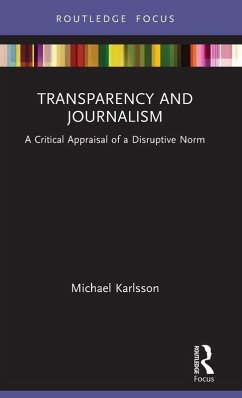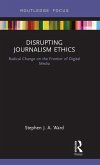- Gebundenes Buch
- Merkliste
- Auf die Merkliste
- Bewerten Bewerten
- Teilen
- Produkt teilen
- Produkterinnerung
- Produkterinnerung
This book offers a comprehensive, authoritative, and accessible introduction to journalistic transparency.
Andere Kunden interessierten sich auch für
![Doing Ethics in Media Doing Ethics in Media]() Chris RobertsDoing Ethics in Media185,99 €
Chris RobertsDoing Ethics in Media185,99 €![The Broadcast News Toolkit The Broadcast News Toolkit]() Kirsten JohnsonThe Broadcast News Toolkit171,99 €
Kirsten JohnsonThe Broadcast News Toolkit171,99 €![Making Journalists Making Journalists]() Hugo de Burgh (ed.)Making Journalists168,99 €
Hugo de Burgh (ed.)Making Journalists168,99 €![Ethics for Journalists Ethics for Journalists]() Sallyanne DuncanEthics for Journalists140,99 €
Sallyanne DuncanEthics for Journalists140,99 €![Data Journalism and the Regeneration of News Data Journalism and the Regeneration of News]() Alfred HermidaData Journalism and the Regeneration of News74,99 €
Alfred HermidaData Journalism and the Regeneration of News74,99 €![Journalism Between the State and the Market Journalism Between the State and the Market]() Helle SjøvaagJournalism Between the State and the Market64,99 €
Helle SjøvaagJournalism Between the State and the Market64,99 €![Disrupting Journalism Ethics Disrupting Journalism Ethics]() Stephen J A WardDisrupting Journalism Ethics59,99 €
Stephen J A WardDisrupting Journalism Ethics59,99 €-
-
-
This book offers a comprehensive, authoritative, and accessible introduction to journalistic transparency.
Produktdetails
- Produktdetails
- Verlag: Routledge
- Seitenzahl: 130
- Erscheinungstermin: 16. August 2021
- Englisch
- Abmessung: 222mm x 145mm x 11mm
- Gewicht: 304g
- ISBN-13: 9780367356163
- ISBN-10: 0367356163
- Artikelnr.: 62223089
- Herstellerkennzeichnung
- Libri GmbH
- Europaallee 1
- 36244 Bad Hersfeld
- gpsr@libri.de
- Verlag: Routledge
- Seitenzahl: 130
- Erscheinungstermin: 16. August 2021
- Englisch
- Abmessung: 222mm x 145mm x 11mm
- Gewicht: 304g
- ISBN-13: 9780367356163
- ISBN-10: 0367356163
- Artikelnr.: 62223089
- Herstellerkennzeichnung
- Libri GmbH
- Europaallee 1
- 36244 Bad Hersfeld
- gpsr@libri.de
Michael Karlsson is professor in media and communication at Karlstad University, Sweden. His research interest lies primarily within digital journalism and his work has been widely published in journals such as Digital Journalism, Journalism Studies, Journalism, Journalism and Mass Communication Quarterly, Journal of Computer-Mediated Communication, and Communication Theory.
Preface and Acknowledgements
1 Transparency and its Connection to Journalism
1.1 Transparency: Essence, Purpose, and How it Made its Way into Journalism
1.2 The Fragile Theoretical and Empirical Foundation of Transparency in
Journalism
1.3 Transparency as Ritual in Journalistic Practice
1.4 Theoretical Points of Departure Influencing the Book
1.5 The Imagined Audience, Structure, and Content of the Book
2 Journalistic Transparency in History and Context
2.1 The Emergence and Solidification of Transparency
2.2 The Philosophical Roots of Transparency in Liberal Democratic Theory
2.3 Comparing the Transparency Dimension in Governmental and Journalistic
Institutions
2.4 The Implicit Theory of Transparency
2.5 The Performative Transparency Model
2.6 Black Box and Glass Box
2.7 Summary
3 Can You See the Sunlight? Transparency at Work
3.1 Can You See the Sunlight?
3.2 Journalistic Actors
3.3 Content: Stage, Aesthetics, and Delivery
3.4 The Public
3.5 ... And transparency for all?
3.6 Transparency in Practice: Not Much Sunlight Thus Far
4 Algorithmic Forms of Transparency and Opacity
4.1 The Increasing Role of Algorithms in Journalism
4.2 Russian Dolls: Black Boxes Inside Other Black Boxes, Inside...
4.3 Unpacking the Role of Algorithms in Transparent Journalistic
Performance
4.4 Computer Says No
5 The Limits of the Transparency Myth
5.1 Inevitable Cost/Benefit Trade-Offs
5.2 The Need for Professional Discretion and the Ever-Present Curtain and
Backstage
5.3 Transparency as the Opposite of Trust
5.4 Transparency is not Openness
5.5 A Successful Flop: How Transparency was Adopted Despite a Lack of
Evidence
5.6 What is Left of Transparency?
6 Transparency After All?
6.1 Three Waves of Transparency in Journalism
6.2 Transparency Pathways
6.3 Targeted Transparency
6.4 Suggestions for a Future Research Agenda
6.5 Not so Disruptive After All
1 Transparency and its Connection to Journalism
1.1 Transparency: Essence, Purpose, and How it Made its Way into Journalism
1.2 The Fragile Theoretical and Empirical Foundation of Transparency in
Journalism
1.3 Transparency as Ritual in Journalistic Practice
1.4 Theoretical Points of Departure Influencing the Book
1.5 The Imagined Audience, Structure, and Content of the Book
2 Journalistic Transparency in History and Context
2.1 The Emergence and Solidification of Transparency
2.2 The Philosophical Roots of Transparency in Liberal Democratic Theory
2.3 Comparing the Transparency Dimension in Governmental and Journalistic
Institutions
2.4 The Implicit Theory of Transparency
2.5 The Performative Transparency Model
2.6 Black Box and Glass Box
2.7 Summary
3 Can You See the Sunlight? Transparency at Work
3.1 Can You See the Sunlight?
3.2 Journalistic Actors
3.3 Content: Stage, Aesthetics, and Delivery
3.4 The Public
3.5 ... And transparency for all?
3.6 Transparency in Practice: Not Much Sunlight Thus Far
4 Algorithmic Forms of Transparency and Opacity
4.1 The Increasing Role of Algorithms in Journalism
4.2 Russian Dolls: Black Boxes Inside Other Black Boxes, Inside...
4.3 Unpacking the Role of Algorithms in Transparent Journalistic
Performance
4.4 Computer Says No
5 The Limits of the Transparency Myth
5.1 Inevitable Cost/Benefit Trade-Offs
5.2 The Need for Professional Discretion and the Ever-Present Curtain and
Backstage
5.3 Transparency as the Opposite of Trust
5.4 Transparency is not Openness
5.5 A Successful Flop: How Transparency was Adopted Despite a Lack of
Evidence
5.6 What is Left of Transparency?
6 Transparency After All?
6.1 Three Waves of Transparency in Journalism
6.2 Transparency Pathways
6.3 Targeted Transparency
6.4 Suggestions for a Future Research Agenda
6.5 Not so Disruptive After All
Preface and Acknowledgements
1 Transparency and its Connection to Journalism
1.1 Transparency: Essence, Purpose, and How it Made its Way into Journalism
1.2 The Fragile Theoretical and Empirical Foundation of Transparency in Journalism
1.3 Transparency as Ritual in Journalistic Practice
1.4 Theoretical Points of Departure Influencing the Book
1.5 The Imagined Audience, Structure, and Content of the Book
2 Journalistic Transparency in History and Context
2.1 The Emergence and Solidification of Transparency
2.2 The Philosophical Roots of Transparency in Liberal Democratic Theory
2.3 Comparing the Transparency Dimension in Governmental and Journalistic Institutions
2.4 The Implicit Theory of Transparency
2.5 The Performative Transparency Model
2.6 Black Box and Glass Box
2.7 Summary
3 Can You See the Sunlight? Transparency at Work
3.1 Can You See the Sunlight?
3.2 Journalistic Actors
3.3 Content: Stage, Aesthetics, and Delivery
3.4 The Public
3.5 ... And transparency for all?
3.6 Transparency in Practice: Not Much Sunlight Thus Far
4 Algorithmic Forms of Transparency and Opacity
4.1 The Increasing Role of Algorithms in Journalism
4.2 Russian Dolls: Black Boxes Inside Other Black Boxes, Inside...
4.3 Unpacking the Role of Algorithms in Transparent Journalistic Performance
4.4 Computer Says No
5 The Limits of the Transparency Myth
5.1 Inevitable Cost/Benefit Trade-Offs
5.2 The Need for Professional Discretion and the Ever-Present Curtain and Backstage
5.3 Transparency as the Opposite of Trust
5.4 Transparency is not Openness
5.5 A Successful Flop: How Transparency was Adopted Despite a Lack of Evidence
5.6 What is Left of Transparency?
6 Transparency After All?
6.1 Three Waves of Transparency in Journalism
6.2 Transparency Pathways
6.3 Targeted Transparency
6.4 Suggestions for a Future Research Agenda
6.5 Not so Disruptive After All
1 Transparency and its Connection to Journalism
1.1 Transparency: Essence, Purpose, and How it Made its Way into Journalism
1.2 The Fragile Theoretical and Empirical Foundation of Transparency in Journalism
1.3 Transparency as Ritual in Journalistic Practice
1.4 Theoretical Points of Departure Influencing the Book
1.5 The Imagined Audience, Structure, and Content of the Book
2 Journalistic Transparency in History and Context
2.1 The Emergence and Solidification of Transparency
2.2 The Philosophical Roots of Transparency in Liberal Democratic Theory
2.3 Comparing the Transparency Dimension in Governmental and Journalistic Institutions
2.4 The Implicit Theory of Transparency
2.5 The Performative Transparency Model
2.6 Black Box and Glass Box
2.7 Summary
3 Can You See the Sunlight? Transparency at Work
3.1 Can You See the Sunlight?
3.2 Journalistic Actors
3.3 Content: Stage, Aesthetics, and Delivery
3.4 The Public
3.5 ... And transparency for all?
3.6 Transparency in Practice: Not Much Sunlight Thus Far
4 Algorithmic Forms of Transparency and Opacity
4.1 The Increasing Role of Algorithms in Journalism
4.2 Russian Dolls: Black Boxes Inside Other Black Boxes, Inside...
4.3 Unpacking the Role of Algorithms in Transparent Journalistic Performance
4.4 Computer Says No
5 The Limits of the Transparency Myth
5.1 Inevitable Cost/Benefit Trade-Offs
5.2 The Need for Professional Discretion and the Ever-Present Curtain and Backstage
5.3 Transparency as the Opposite of Trust
5.4 Transparency is not Openness
5.5 A Successful Flop: How Transparency was Adopted Despite a Lack of Evidence
5.6 What is Left of Transparency?
6 Transparency After All?
6.1 Three Waves of Transparency in Journalism
6.2 Transparency Pathways
6.3 Targeted Transparency
6.4 Suggestions for a Future Research Agenda
6.5 Not so Disruptive After All
Preface and Acknowledgements
1 Transparency and its Connection to Journalism
1.1 Transparency: Essence, Purpose, and How it Made its Way into Journalism
1.2 The Fragile Theoretical and Empirical Foundation of Transparency in
Journalism
1.3 Transparency as Ritual in Journalistic Practice
1.4 Theoretical Points of Departure Influencing the Book
1.5 The Imagined Audience, Structure, and Content of the Book
2 Journalistic Transparency in History and Context
2.1 The Emergence and Solidification of Transparency
2.2 The Philosophical Roots of Transparency in Liberal Democratic Theory
2.3 Comparing the Transparency Dimension in Governmental and Journalistic
Institutions
2.4 The Implicit Theory of Transparency
2.5 The Performative Transparency Model
2.6 Black Box and Glass Box
2.7 Summary
3 Can You See the Sunlight? Transparency at Work
3.1 Can You See the Sunlight?
3.2 Journalistic Actors
3.3 Content: Stage, Aesthetics, and Delivery
3.4 The Public
3.5 ... And transparency for all?
3.6 Transparency in Practice: Not Much Sunlight Thus Far
4 Algorithmic Forms of Transparency and Opacity
4.1 The Increasing Role of Algorithms in Journalism
4.2 Russian Dolls: Black Boxes Inside Other Black Boxes, Inside...
4.3 Unpacking the Role of Algorithms in Transparent Journalistic
Performance
4.4 Computer Says No
5 The Limits of the Transparency Myth
5.1 Inevitable Cost/Benefit Trade-Offs
5.2 The Need for Professional Discretion and the Ever-Present Curtain and
Backstage
5.3 Transparency as the Opposite of Trust
5.4 Transparency is not Openness
5.5 A Successful Flop: How Transparency was Adopted Despite a Lack of
Evidence
5.6 What is Left of Transparency?
6 Transparency After All?
6.1 Three Waves of Transparency in Journalism
6.2 Transparency Pathways
6.3 Targeted Transparency
6.4 Suggestions for a Future Research Agenda
6.5 Not so Disruptive After All
1 Transparency and its Connection to Journalism
1.1 Transparency: Essence, Purpose, and How it Made its Way into Journalism
1.2 The Fragile Theoretical and Empirical Foundation of Transparency in
Journalism
1.3 Transparency as Ritual in Journalistic Practice
1.4 Theoretical Points of Departure Influencing the Book
1.5 The Imagined Audience, Structure, and Content of the Book
2 Journalistic Transparency in History and Context
2.1 The Emergence and Solidification of Transparency
2.2 The Philosophical Roots of Transparency in Liberal Democratic Theory
2.3 Comparing the Transparency Dimension in Governmental and Journalistic
Institutions
2.4 The Implicit Theory of Transparency
2.5 The Performative Transparency Model
2.6 Black Box and Glass Box
2.7 Summary
3 Can You See the Sunlight? Transparency at Work
3.1 Can You See the Sunlight?
3.2 Journalistic Actors
3.3 Content: Stage, Aesthetics, and Delivery
3.4 The Public
3.5 ... And transparency for all?
3.6 Transparency in Practice: Not Much Sunlight Thus Far
4 Algorithmic Forms of Transparency and Opacity
4.1 The Increasing Role of Algorithms in Journalism
4.2 Russian Dolls: Black Boxes Inside Other Black Boxes, Inside...
4.3 Unpacking the Role of Algorithms in Transparent Journalistic
Performance
4.4 Computer Says No
5 The Limits of the Transparency Myth
5.1 Inevitable Cost/Benefit Trade-Offs
5.2 The Need for Professional Discretion and the Ever-Present Curtain and
Backstage
5.3 Transparency as the Opposite of Trust
5.4 Transparency is not Openness
5.5 A Successful Flop: How Transparency was Adopted Despite a Lack of
Evidence
5.6 What is Left of Transparency?
6 Transparency After All?
6.1 Three Waves of Transparency in Journalism
6.2 Transparency Pathways
6.3 Targeted Transparency
6.4 Suggestions for a Future Research Agenda
6.5 Not so Disruptive After All
Preface and Acknowledgements
1 Transparency and its Connection to Journalism
1.1 Transparency: Essence, Purpose, and How it Made its Way into Journalism
1.2 The Fragile Theoretical and Empirical Foundation of Transparency in Journalism
1.3 Transparency as Ritual in Journalistic Practice
1.4 Theoretical Points of Departure Influencing the Book
1.5 The Imagined Audience, Structure, and Content of the Book
2 Journalistic Transparency in History and Context
2.1 The Emergence and Solidification of Transparency
2.2 The Philosophical Roots of Transparency in Liberal Democratic Theory
2.3 Comparing the Transparency Dimension in Governmental and Journalistic Institutions
2.4 The Implicit Theory of Transparency
2.5 The Performative Transparency Model
2.6 Black Box and Glass Box
2.7 Summary
3 Can You See the Sunlight? Transparency at Work
3.1 Can You See the Sunlight?
3.2 Journalistic Actors
3.3 Content: Stage, Aesthetics, and Delivery
3.4 The Public
3.5 ... And transparency for all?
3.6 Transparency in Practice: Not Much Sunlight Thus Far
4 Algorithmic Forms of Transparency and Opacity
4.1 The Increasing Role of Algorithms in Journalism
4.2 Russian Dolls: Black Boxes Inside Other Black Boxes, Inside...
4.3 Unpacking the Role of Algorithms in Transparent Journalistic Performance
4.4 Computer Says No
5 The Limits of the Transparency Myth
5.1 Inevitable Cost/Benefit Trade-Offs
5.2 The Need for Professional Discretion and the Ever-Present Curtain and Backstage
5.3 Transparency as the Opposite of Trust
5.4 Transparency is not Openness
5.5 A Successful Flop: How Transparency was Adopted Despite a Lack of Evidence
5.6 What is Left of Transparency?
6 Transparency After All?
6.1 Three Waves of Transparency in Journalism
6.2 Transparency Pathways
6.3 Targeted Transparency
6.4 Suggestions for a Future Research Agenda
6.5 Not so Disruptive After All
1 Transparency and its Connection to Journalism
1.1 Transparency: Essence, Purpose, and How it Made its Way into Journalism
1.2 The Fragile Theoretical and Empirical Foundation of Transparency in Journalism
1.3 Transparency as Ritual in Journalistic Practice
1.4 Theoretical Points of Departure Influencing the Book
1.5 The Imagined Audience, Structure, and Content of the Book
2 Journalistic Transparency in History and Context
2.1 The Emergence and Solidification of Transparency
2.2 The Philosophical Roots of Transparency in Liberal Democratic Theory
2.3 Comparing the Transparency Dimension in Governmental and Journalistic Institutions
2.4 The Implicit Theory of Transparency
2.5 The Performative Transparency Model
2.6 Black Box and Glass Box
2.7 Summary
3 Can You See the Sunlight? Transparency at Work
3.1 Can You See the Sunlight?
3.2 Journalistic Actors
3.3 Content: Stage, Aesthetics, and Delivery
3.4 The Public
3.5 ... And transparency for all?
3.6 Transparency in Practice: Not Much Sunlight Thus Far
4 Algorithmic Forms of Transparency and Opacity
4.1 The Increasing Role of Algorithms in Journalism
4.2 Russian Dolls: Black Boxes Inside Other Black Boxes, Inside...
4.3 Unpacking the Role of Algorithms in Transparent Journalistic Performance
4.4 Computer Says No
5 The Limits of the Transparency Myth
5.1 Inevitable Cost/Benefit Trade-Offs
5.2 The Need for Professional Discretion and the Ever-Present Curtain and Backstage
5.3 Transparency as the Opposite of Trust
5.4 Transparency is not Openness
5.5 A Successful Flop: How Transparency was Adopted Despite a Lack of Evidence
5.6 What is Left of Transparency?
6 Transparency After All?
6.1 Three Waves of Transparency in Journalism
6.2 Transparency Pathways
6.3 Targeted Transparency
6.4 Suggestions for a Future Research Agenda
6.5 Not so Disruptive After All
"Michael Karlsson is one of the preemi-nent scholars on transparency in journalism... [his] book, written in a re-freshing, self-reflective tone, offers vital insights for both researchers and journal-ism practitioners" - Michael Koliska Assistant Professor Communication, Culture and Technology Georgetown University Washington, DC, USA








